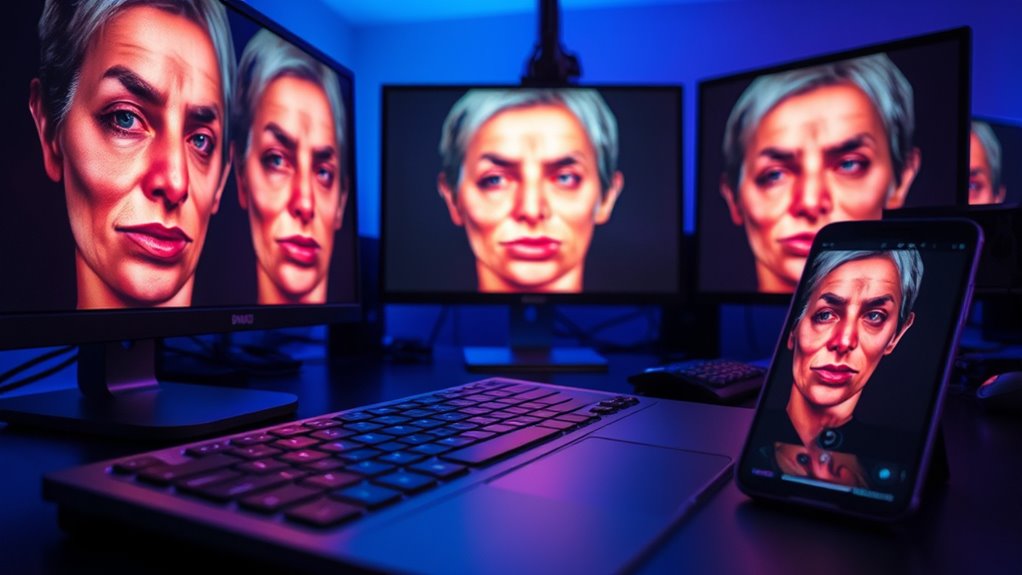AI-generated deepfakes are revolutionizing identity theft, making it easier for fraudsters to impersonate trusted individuals convincingly. These realistic videos, voices, and forged documents bypass traditional security measures and challenge verification systems. With over 8 million deepfake files in circulation, the risk of scams and financial loss skyrockets. Staying ahead of these threats requires understanding the techniques used and the strategies to protect yourself—more detailed insights await if you continue exploring this topic.
Key Takeaways
- AI-generated deepfakes enable convincing impersonations, making identity theft easier through fake videos, audio, and documents.
- Deepfakes can bypass traditional verification methods, increasing the risk of unauthorized access and financial fraud.
- Criminals use synthetic media to impersonate individuals during verification or transactions, facilitating identity theft at scale.
- The rapid growth of deepfake technology challenges existing detection systems, requiring advanced, real-time AI detection tools.
- Industry and regulatory efforts aim to improve detection standards and raise awareness to combat deepfake-based identity theft.
The Explosion of Synthetic Media in Fraud Schemes

The use of synthetic media in fraud schemes has exploded in recent years, driven by advances in generative AI technology. You’ll notice a sharp rise in deepfake files, jumping from 500,000 in 2023 to over 8 million in 2025. Fraudsters now create highly convincing videos, audio clips, and forged documents that are nearly indistinguishable from real ones. These tools are accessible to non-experts, making it easier than ever to craft sophisticated scams. As a result, deepfake-related attacks have skyrocketed, with attempts increasing by thousands of percent. Every day, criminals leverage AI to impersonate executives, manipulate identities, and produce fake content at scale. The rapid growth of synthetic media signifies a fundamental shift in how fraudsters operate, making detection more challenging and threatening digital trust worldwide. Additionally, the emergence of generational AI techniques complicates efforts to develop effective detection tools, further amplifying the risks associated with deepfake technology. The increasing availability of cybersecurity awareness resources helps individuals and organizations recognize and defend against these evolving threats. As digital trust continues to erode, the sophistication of these tools underscores the importance of proactive measures to combat such threats. Staying informed about emerging AI-driven scams is crucial for maintaining security in this rapidly changing landscape.
How Deepfakes Disrupt Digital Identity Verification

Deepfakes make impersonation easier and more convincing, putting your identity verification processes at risk. As fraudsters use AI to mimic voices, faces, and documents, detection becomes increasingly difficult. This rising sophistication challenges existing security measures, forcing you to find new ways to stay ahead. Additionally, understanding the divorce guidance landscape can be crucial for individuals navigating identity security during personal changes. Employing advanced exfoliation techniques like glycolic acid can also enhance skin clarity, which is vital when verifying identities through facial recognition systems. To combat these threats, integrating professional hair color brands into digital identity verification processes can help ensure consistent and reliable facial recognition results. Recognizing personality traits that influence behavior can also aid in developing more robust verification methods that adapt to various user profiles. Moreover, being aware of cookie and privacy policies can help safeguard your personal data from unauthorized access during online verification.
Deepfake Impersonation Risks
As AI-generated deepfakes become more sophisticated, they pose a serious threat to digital identity verification systems. You might find it easier for fraudsters to impersonate you convincingly, bypassing facial recognition or voice authentication. Deepfake videos or audio can mimic your appearance and speech, making it difficult to distinguish genuine from fake. This enables scammers to access sensitive accounts, approve transactions, or create synthetic identities that blend real and fabricated data. With real-time manipulation, impersonators can deceive verification processes during live interactions, increasing the risk of successful fraud. Additionally, the loss of biodiversity associated with increased digital threats undermines trust in security measures, demanding more advanced defenses. This challenge underscores the importance of developing cultural intelligence in security to understand and counteract emerging deception tactics. As a result, your personal and financial information becomes more vulnerable to theft, and trust in digital onboarding diminishes. The erosion of trust in security measures further complicates efforts to combat these threats, highlighting the need for more resilient solutions. The integration of AI in security is essential to develop next-generation verification systems capable of detecting sophisticated deepfakes. Implementing advanced detection algorithms can help identify subtle inconsistencies in deepfake media, bolstering defenses against impersonation.
Detection Challenges Intensify
Detecting AI-generated deepfakes has become increasingly difficult because advanced synthetic media can now mimic human features with uncanny accuracy, fooling traditional verification methods. Deepfakes can convincingly imitate voices, facial expressions, and gestures, making visual and audio checks unreliable. Fraudsters use sophisticated tools to produce hyper-realistic videos and audio clips that bypass standard detection techniques. Automated systems struggle to keep pace with rapidly evolving deepfake technology, which constantly improves in realism. As a result, you face mounting challenges in verifying identities during onboarding and transactions. Human intuition alone is no longer enough to detect deception, compelling organizations to adopt AI-driven, real-time detection tools. Staying ahead requires continuous innovation and proactive security measures to protect against increasingly convincing deepfake attacks.
Techniques Empowering Fraudsters With Generative AI

Generative AI has revolutionized the way fraudsters create convincing forgeries, making high-quality video, audio, and document manipulation accessible even to those without technical expertise. You can now produce realistic deepfakes in seconds, using user-friendly tools. Fraudsters leverage AI to clone voices, alter faces in videos, and forge official documents seamlessly. This technology enables live impersonations during identity checks and quick creation of convincing phishing emails. Here’s a quick look at some techniques:
| Technique | How it’s Used |
|---|---|
| AI voice cloning | Mimics familiar voices for scams |
| Deepfake videos | Real-time impersonations during verification |
| Synthetic document creation | Forged IDs and official papers |
| Text generation models | Crafting convincing phishing messages |
| Media manipulation tools | Realistic fake images and audio |
The widespread use of these tools underscores the importance of security measures and ongoing vigilance in verifying identities, especially considering the safety features modern devices incorporate to prevent overheating or malfunction. Recognizing the rapid technological advancements that facilitate these malicious activities emphasizes the need for continuous development of detection and prevention methods. Additionally, understanding the creative potential of AI highlights the challenge of distinguishing authentic content from manipulated media, which is crucial in combating misuse. Understanding the potential for misuse of AI highlights the necessity for advanced detection methods to combat these emerging threats.
The Escalating Financial Impact of Deepfake-Driven Crimes

Deepfake-driven crimes are causing a rapidly escalating financial toll worldwide, with fraud losses reaching staggering levels. You might not realize how much this technology costs organizations and individuals alike. In 2024, global scam losses attributed to AI-driven fraud hit $1 trillion, with North American losses exceeding $200 million in just the first quarter of 2025. The U.S. alone is projected to see generative AI fraud reach $40 billion by 2027. These crimes target digital onboarding, identity verification, and financial transactions, leading to massive financial damage. Businesses face not only direct monetary losses but also reputational harm and increased compliance costs. As fraudsters leverage high-quality deepfakes for scams, the financial impact continues to grow exponentially, threatening the stability of digital economies worldwide. Proper storage in a cool, dark place can help prevent the spoilage of digital assets and ensure they remain secure from tampering. Implementing advanced sound design techniques in cybersecurity measures can also aid in detecting and countering deepfake attacks more effectively.
Challenges in Detecting AI-Generated Forgeries

You face growing challenges in identifying AI-generated forgeries because deepfake techniques keep advancing, making synthetic media more realistic and harder to spot. Detection technologies often lag behind these evolving methods, struggling to keep up with sophisticated manipulations. As a result, staying ahead requires continuous innovation and adaptation in your security measures.
Evolving Deepfake Techniques
As AI-generated deepfake techniques continue to evolve, detecting these forgeries becomes increasingly difficult. Fraudsters now produce highly realistic videos, audio, and documents that are nearly indistinguishable from genuine content. Live video manipulation allows real-time impersonations during identity checks, making it harder to spot suspicious activity. Voice cloning technology replicates familiar voices with uncanny accuracy, enabling convincing scams. Generative AI tools are accessible to non-experts, lowering the barrier for creating sophisticated forgeries. Additionally, synthetic identities combine real and fake data, complicating verification processes. These advancements mean traditional detection methods often fall short, as deepfakes become more seamless and convincing. The rapid pace of innovation in deepfake techniques continuously challenges existing security protocols, requiring ongoing adaptation to stay ahead of malicious actors.
Detection Technology Limitations
Advancements in deepfake techniques have made synthetic media increasingly indistinguishable from genuine content, posing significant challenges for detection technologies. You find that traditional detection methods, such as metadata analysis or simple visual checks, no longer suffice against sophisticated deepfakes. AI-generated media can mimic facial expressions, voice patterns, and even subtle inconsistencies, making it difficult to identify fakes in real-time. Detection tools struggle to keep pace with rapid innovations, often lagging behind the evolving techniques used by fraudsters. Additionally, deepfakes can be tailored to bypass existing security measures, rendering many algorithms ineffective. As a result, you face an ongoing arms race—fraudsters continuously improve their forgeries, while detection systems require constant updates, making reliable identification increasingly complex and resource-intensive.
Evolving Strategies to Combat Deepfake Fraud

To effectively combat the rising sophistication of deepfake fraud, organizations must adopt adaptive and proactive strategies that outpace the evolving tactics of fraudsters. You should prioritize investing in AI-powered detection tools that analyze real-time media for anomalies. Implement multi-layered verification processes, combining biometric, behavioral, and contextual data to identify inconsistencies. Regularly update security protocols based on emerging threats and leverage machine learning models that adapt to new deepfake techniques. Educate your staff and customers about common scams and warning signs to reduce human error. Collaborate with industry peers and regulators to share threat intelligence and develop standardized detection frameworks. Staying vigilant, embracing innovation, and fostering agility in your security posture are essential to stay ahead of increasingly sophisticated deepfake attacks.
The Role of Industry and Regulatory Collaboration

Industry and regulatory collaboration play a crucial role in combating the rapidly evolving threat of deepfake fraud. You need coordinated efforts to develop standardized detection methods, share intelligence, and establish best practices. Cross-sector partnerships between tech companies, financial institutions, and regulators can accelerate the deployment of advanced AI-detection tools, making it harder for fraudsters to succeed. Regulatory frameworks must evolve quickly to set clear guidelines for identifying and reporting deepfake-related crimes, ensuring accountability and consumer protection. By working together, industries can create a unified front against emerging threats, sharing insights and technological innovations. This collaboration not only enhances current defenses but also drives innovation, making it possible to stay ahead of increasingly sophisticated deepfake attacks. Strong partnerships are essential to safeguarding digital identity and maintaining trust.
Educating the Public About AI-Driven Cyber Threats

Have you ever wondered how convincing AI-generated deepfakes can be and how easily they can deceive you? Many people underestimate the threat these synthetic media pose. Educating the public is essential to recognize signs of manipulation and avoid scams. You need to understand how AI can mimic voices, faces, and documents with high accuracy. Awareness campaigns should focus on common tactics used by fraudsters, such as deepfake videos or AI-powered voice calls. Here’s a quick look at some key differences:
| Fake Content | Real Content |
|---|---|
| Created with AI | Genuine origin |
| Hard to detect visually | Authentic cues present |
| Can be manipulated in real-time | Static, unaltered |
| Often used in scams | Usually legitimate |
Preparing for a Future Dominated by Deepfake Risks

As awareness of AI-driven scams grows, it’s clear that simply knowing about deepfakes isn’t enough to stay protected. You need to actively prepare by adopting advanced security measures that can keep pace with evolving threats. Implement multi-factor authentication and biometric verification to add layers of defense against sophisticated impersonation. Invest in AI-powered detection tools that analyze media authenticity in real time. Educate your team and customers on recognizing signs of deepfake scams, emphasizing cautious communication. Regularly update your cybersecurity protocols to address new attack vectors. Collaborate with industry peers and regulators to stay informed about emerging threats and best practices. By proactively strengthening defenses, you can reduce vulnerabilities and safeguard your digital identity against the rising tide of deepfake fraud.
Frequently Asked Questions
How Quickly Can Deepfake Technology Adapt to Bypass New Detection Methods?
Deepfake technology can adapt remarkably fast to bypass new detection methods, often within weeks or even days. As detection tools improve, fraudsters refine their techniques using AI to identify and exploit vulnerabilities swiftly. This rapid evolution means you need to stay ahead by continuously updating your security measures, investing in AI-driven detection, and remaining vigilant, because the cycle of innovation and countermeasures is ongoing and relentless.
What Legal Measures Are in Place to Hold Deepfake Fraudsters Accountable?
You might think laws are enough, but current legal measures often lag behind rapidly evolving deepfake crimes. Still, many countries are implementing regulations that criminalize malicious use of synthetic media, establish penalties for identity theft, and require tech companies to develop detection tools. You should stay informed about emerging legislation and advocate for stricter enforcement, as holding fraudsters accountable depends on both legal action and technological safeguards.
How Effective Are Current Biometric Authentication Methods Against Synthetic Media?
You might find current biometric authentication methods increasingly ineffective against synthetic media. Fraudsters use AI to create realistic deepfakes, fooling facial recognition or voice verification systems. While some advanced biometrics incorporate liveness detection, many still struggle to distinguish genuine from fake. To stay protected, you should advocate for multi-factor authentication and constantly update security protocols, as relying solely on traditional biometric methods leaves you vulnerable to sophisticated deepfake attacks.
Can Ai-Driven Detection Systems Keep up With the Rapid Evolution of Deepfake Techniques?
You need to realize that AI-driven detection systems are racing against a wildfire—constantly spreading and evolving. While they’re improving, deepfake techniques are advancing faster, like a chameleon blending into new environments. To stay ahead, you must invest in adaptive, real-time solutions and continuous updates. Relying on static defenses is like fighting a forest fire with a garden hose; only innovation and vigilance can truly contain the threat.
What Industries Are Most Vulnerable to Deepfake-Based Identity Theft?
You should know that finance, healthcare, and government sectors are most vulnerable to deepfake-based identity theft. Hackers target banks and financial institutions to access accounts, while healthcare providers face risks of false identities and fraudulent claims. Governments are also at risk, as deepfakes can manipulate identities for visas, passports, or official records. Staying vigilant and investing in advanced detection tools is essential to protect these high-risk industries from evolving deepfake threats.
Conclusion
As you navigate a world flooded with convincing deepfakes, remember that every new shadow cast by AI is like a crack in the mirror of trust. Stay vigilant, stay informed, and don’t let these digital illusions fool you. Together, through awareness and collaboration, you can help hold back the tide of deception and keep your identity safe in this evolving battleground of truth and falsehood.









